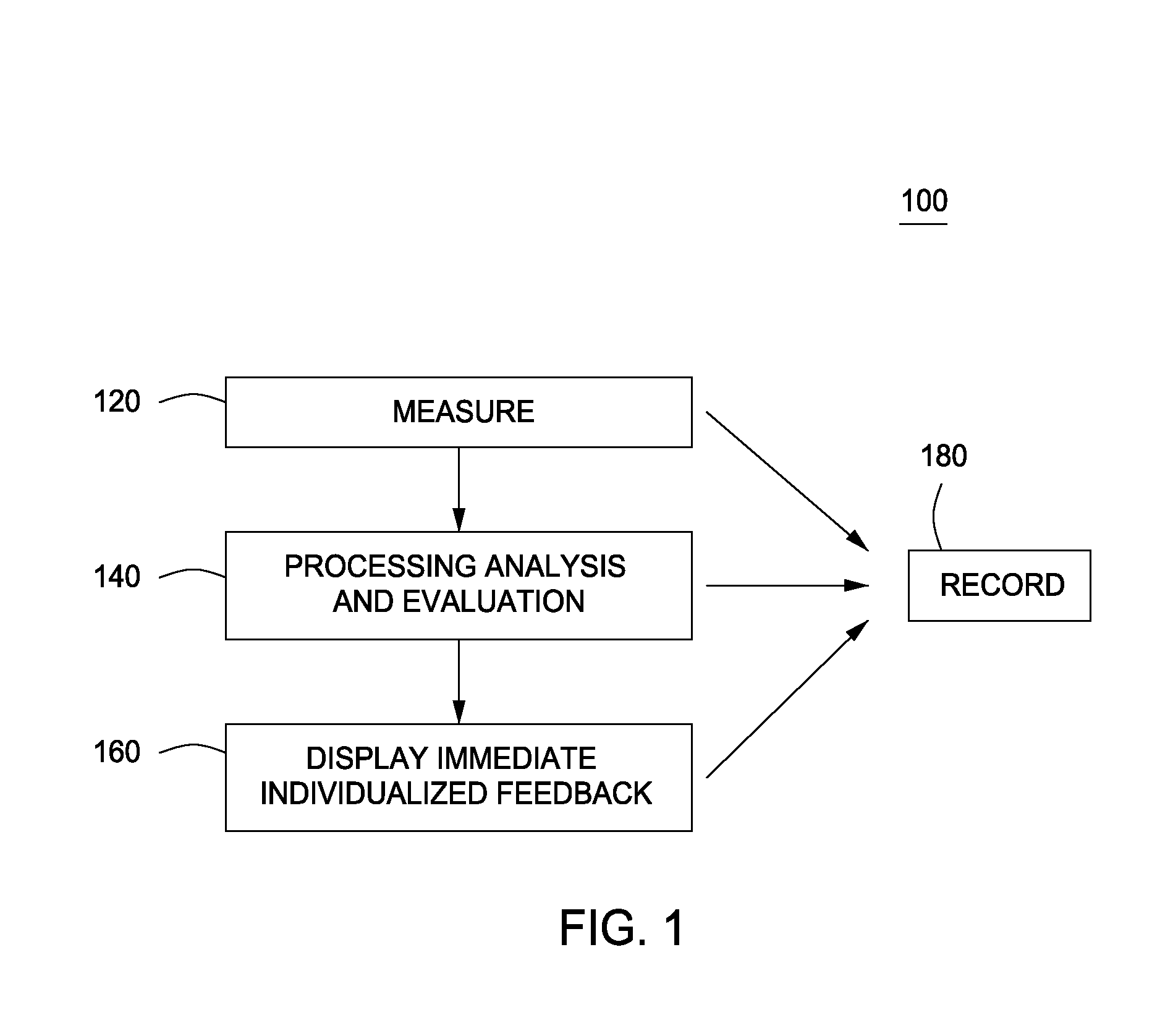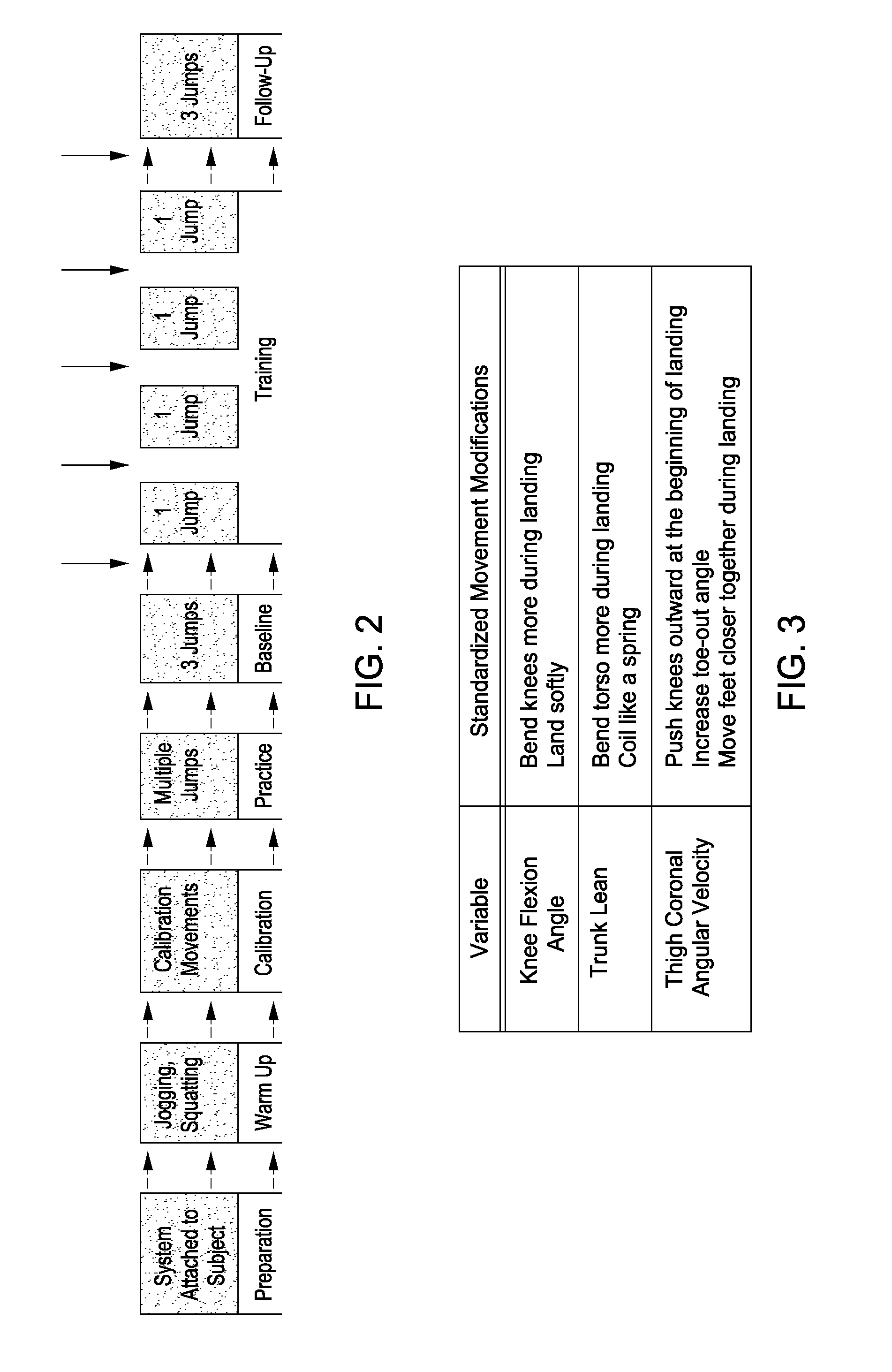Systems and methods for measuring, analyzing, and providing feedback for movement in multidimensional space
a multi-dimensional space and multi-dimensional space technology, applied in the field of systems and methods for providing feedback for movement in multi-dimensional space, can solve the problem that the knee joint is one of the most commonly injured joints, and achieve the effect of improving performance, and reducing the risk of injury
- Summary
- Abstract
- Description
- Claims
- Application Information
AI Technical Summary
Benefits of technology
Problems solved by technology
Method used
Image
Examples
example 1
Anterior Cruciate Ligament (ACL) Injury Prevention
[0061]Extensive sections of the following example is excerpted from Dowling A V, Favre J, Andriacchi T P, entitled “Inertial sensor-based feedback can reduce key risk metrics for ACL injury during jump landings.” The final definitive version of this paper is in press to be published in the American Journal of Sports Medicine, by SAGE Publications, Inc., all rights reserved.
[0062]The anterior cruciate ligament (ACL) is the most commonly injured ligament of the knee, and loss of this ligament often leads to premature degenerative arthritis of the knee. As such, researchers have developed intervention programs that can successfully decrease the incidence of ACL injury. These preventive programs are generally six to eight weeks in duration and require two to three training sessions per week that are focused on altering lower extremity biomechanics. Most of these training sessions occur during team practices because the participants canno...
example 2
Perfecting Squatting Form
[0089]The squat (and the related weighted squat) is one of the most frequently used exercises in the field of strength and conditioning. It is a core exercise in many training regimens because it is biomechanically and neuromuscularly similar to a wide range of athletic movements. It is also relevant to non-athletes because it trains multiple muscle groups in a single maneuver, similar to common activities of daily living like lifting packages and picking up children. Squats have also been used to strengthen lower-body muscles during rehabilitation after a joint injury (see Schoenfeld, J. Strength. Cond. Res., 24:12 (2010)).
[0090]Injuries related to the squat exercise are minimal when participants perform the exercise correctly, with proper technique and appropriate weight. However, poor squatting technique can lead to serious injury, especially during a weighted squat with heavy weights. These injuries include muscle and ligament strains, and spine maladies...
example 3
Optimizing Baseball Throwing Mechanics
[0096]Throwing a baseball is a coordinated motion that starts in the toes and ends in the fingertips. A precise sequence of muscle activity, starting in the lower body, is required to transmit energy to the ball. Baseball pitchers complete thousands of throws to learn the skills necessary to execute a fastball, curveball, and the many other throws needed to play the game. Each of these throws results in high forces in the arm and especially in the shoulder joint, and pitchers are susceptible to significant shoulder injuries from repetitive stress; for example, in order to achieve ball velocity of 90 mph, the shoulder must rotate at angular velocities of up to 7000° / sec and may be exposed to forces of up to 950 N. In elite-level pitchers, there is a balance that must be achieved between the shoulder mobility that is necessary to reach extreme positions of rotation so that velocity can be transmitted to the ball and the stability that is necessary...
PUM
 Login to View More
Login to View More Abstract
Description
Claims
Application Information
 Login to View More
Login to View More - R&D
- Intellectual Property
- Life Sciences
- Materials
- Tech Scout
- Unparalleled Data Quality
- Higher Quality Content
- 60% Fewer Hallucinations
Browse by: Latest US Patents, China's latest patents, Technical Efficacy Thesaurus, Application Domain, Technology Topic, Popular Technical Reports.
© 2025 PatSnap. All rights reserved.Legal|Privacy policy|Modern Slavery Act Transparency Statement|Sitemap|About US| Contact US: help@patsnap.com



